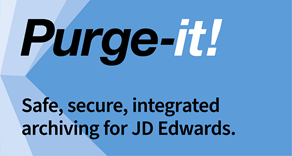
The year in review
Looking back on 2025 milestones and ahead to more JD Edwards in 2026!
Read more >
How do you manage JD Edwards data without JD Edwards?
As your JD Edwards system is retired you may start to lose JD Edwards skills and knowledge. Find out how to address this challenge.
Read more >
Data Management for your JD Edwards Data
Is your organization thinking about the subject of data retention for your JD Edwards system? In this article we explore key discussion points around developing a meaningful Data Retention Policy.
Read more >
What is Data Archiving?
Find out how Data Archiving and Data Purging fit into Data Lifecycle Management
Read more >
How to delete JD Edwards data that has passed its retention date and not just archive it
If your data archive is growing and you need to take action, check out how functionality in Purge-it Version 5.2 allows the possibility to completely remove old data from the archive
Read more >
How to measure the success of Data Archiving (Part 3)
In the final part of this 3 part series of blog articles 'measuring the success of data archiving', we look at two more customer examples
Read more >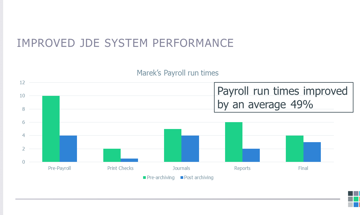
How to measure the success of Data Archiving (Part 2)
In part 2 of 'measuring the success of data archiving', we look at real customer examples
Read more >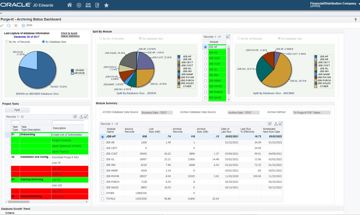
How to measure the success of Data Archiving (Part 1)
Can you measure the impact of data archiving? How do you demonstrate ROI? We address these questions and others in this JD Edwards article
Read more >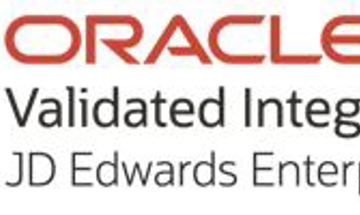
What is Oracle Validated Integration (OVI)?
Find out how Klik IT achieving Oracle Validated Integration with JD Edwards EnterpriseOne Expertise for its integration of Purge-it can help you and your organization
Read more >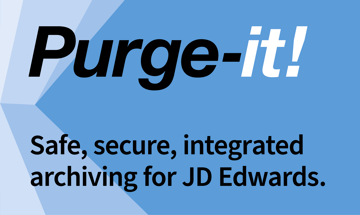
Purge-it Version 5.2 FAQs
Explore some of the most frequently asked questions relating to the latest release of the JD Edwards data archiving solution, Purge-it
Read more >
Is Purge-it easy to use for E1 data archiving?
Purge-it customers tell us one of the key drivers for choosing the data archiving solution is its usability. In this blog post we look at the main factors that make Purge-it easy to use.
Read more >
What is Purge-it?
Find out all about Purge-it. How it works, who it's for and what it offers JD Edwards users
Read more >Get a JD Edwards data healthcheck
In this blog post we look at how the JD Edwards data archiving solution Purge-it! gives your JD Edwards system a health check.
Read more >
30 features of Data Archiving with Purge-it
Discover the top 30 features of data archiving with Purge-it that make it a truly easy product to implement.
Read more >
What is JD Edwards Archiving as a Service?
You're no doubt familiar with the as a Service model. Discover the business benefits of opting for Archiving as a Service for your JD Edwards E1 data archiving needs in this blog post.
Read more >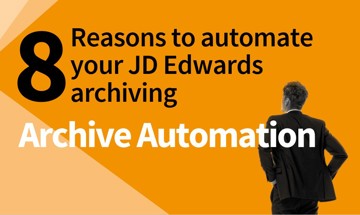
8 reasons to automate your JD Edwards archiving
Checkout this second blog post on archive automation. We zoom in on the 8 top reasons to automate your JD Edwards archiving.
Read more >
What is archive automation for JD Edwards?
Find out how human intervention in the routine task of archiving JD Edwards data can be greatly reduced. We’re talking about archive automation. It can help achieve remarkable ongoing efficiencies.
Read more >What is meant by an integrated JD Edwards archiving solution?
What's the difference between an external and an internal archiving product when it comes to JD Edwards archiving? Read our short blog post as we summarize the differences.
Read more >
Why is JD Edwards running slow?
Deteriorating system performance negatively impacts many job functions across an organization. Find out why you system is slow. Discover how to speed up your JD Edwards system and enhance the user experience.
Read more >
Find out which version of Purge-it! your organization is running
Make sure your organization is maximizing its use of the archiving solution Purge-it! Find out which software version you have. Discover the latest product enhancements and new Purge-it! features and functionality.
Read more >
How Klik IT started 25 years ago...and what's next?
As Klik IT celebrates 25 years in business in 2023, we took some time out to chat to CEO, Terry Clarke.
Read more >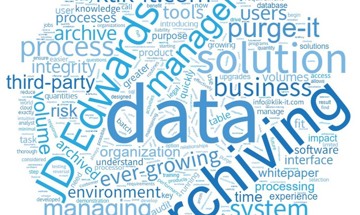
Find a JD Edwards archiving solution that works for your business. Ask these 5 questions.
Is your organization looking for a 3rd party archiving solution?
Checkout 5 key questions to ask when evaluating JD Edwards archiving tools and solutions.
Read more >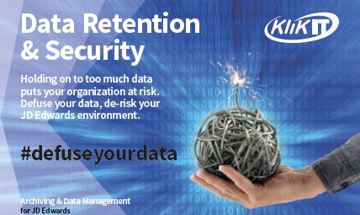
Data Retention & Security
Data Retention and Security is a hot topic and a vast subject.
In this Blog post we look at Data Retention and Security from the perspective of organizations running JD Edwards. We cover the key considerations as we see them and provide links to industry articles and information for a broader view of the subject.
Read more >Get a JD Edwards data healthcheck
Discover how the built-in validation checks and audit of exceptions mean you can easily identify issues with your JD Edwards data that can affect your data archiving.
In this article, we look at the detail behind how this works in Purge-it! from transaction level processing and commitment control through to the audit data that’s generated.
Find out how this powerful functionality can help your business.
Let’s dive straight in!
Transaction level processing
What is transaction level processing?
When we say Purge-it! has transaction level processing we mean everything is performed at a transaction level rather than at a table level.
Let’s take Sales Orders as an example. When Purge-it! archives Sales Orders (SO), it processes one SO at a time. It reads the SO detail and for each line, it checks all tables to ensure it is complete, does not have any open values, and is not related to something that would cause it to be held up from archiving due to related module integrity. Only once the checks are complete does Purge-it! move the whole order into the archive database in one transaction boundary. Purge-it! then continues to process the next order.
Another example is General Ledger. When Purge-it! archives the FO911 it checks to see if there’s an existing balancing entry for that account for the period that’s been processed. If there’s no balancing entry, then it creates a balance forward (BF) record. If a BF record already exists for that combination of accounts and fiscal period, then it will append the amounts onto it. This means the FO911 and FO902 will always be synchronized, even if the run has to be stopped or cancelled half way through.
There’s a lot of validation built into Purge-it! As an example, in General Ledger alone there are over 20 different validations that can be applied to check data is eligible for archiving, many of which are configurable.
Why is transaction level processing important?
The benefit of performing the archiving at transaction level is that you never find yourself in a situation where half an order is in one place and the other half of the order is in another place. In other words, you never face the frustration of having part archived orders or tables even if you stop a job halfway through.
It makes the whole process a lot more controlled, robust, and safe.
Commitment control
Purge-it! uses inbuilt commitment control to protect data boundaries. This ensures your system is never in a situation where some of your data exists in the archive and some of your data is still in production.
For example, if you run the sales module and you’re part way through archiving any one of the 20+ sales tables *, if Purge-it! identifies an issue with the commitments, then the last transaction would be automatically rolled back.
Audit data
What’s the audit of exceptions?
As part of the archive process, Purge-it! generates detailed audit data. It shows what’s been successfully archived, and in the cases where the data has not been archived, you see the reasons why.
These exceptions in the data are identified by Purge-it! as part of the audit data that’s generated. This feature allows you to understand any integrity issues in your data that may affect your archiving activities.
For example, if you have a sales order that hasn’t been archived, it may be that there’s an outstanding accounts receivable document. Alternatively, it could be because the order activity rules haven’t gone to 620 999 for a stock item.
By highlighting integrity issues with the data, this gives an opportunity to go back to the business to address these. Why does this matter? It’s important because you can be sure that nothing will get out of synch during the archiving process. What’s more it’s not just telling you that there are issues with parts of the JDE data but it’s identifying where the open data is in the system. This makes it far easier for the business to address any problem areas.
Summary
When you consider data archiving for JD Edwards, it’s easy to just think about the process as removing older complete data to free up system capacity. However, without the right archiving solution, this can very quickly introduce serious challenges with the integrity of the data, because the JDE data is all interlinked. How will you know that current balances are correct if some of the older figures have been removed? What happens with the auditing?
Purge-it! has all the answers!
- Data integrity is maintained throughout data archiving. Nothing gets out of synch.
- If a process is cancelled mid-way or reversed, the archived data is restored to its original place.
- Detailed and summarized audit data highlights business process and data integrity issues in your environment.
- Developed exclusively for JD Edwards systems, the functionality is tailored to meet JDE users’ needs.
* the exact number depends on the release.
News Snapshot...
Richard Wilde, Product Consultant at Klik,
“I remember when I first saw Purge-it! It was some years ago when I was a contractor for a UK company. I particularly liked the product because it gives your system a health check – particularly the financial modules.”
“We have a number of Purge-it! customers who’ve fixed some serious issues with their systems and JD Edwards data as a result of running Purge-it! In some cases, the companies have also found some monetary gains for items that hadn’t been invoiced in the past - Purge-it! picked up on that.”
![]()
We’re ready to help you get started.
Give your system a health check.
Get cleaner and leaner data for 2024.
- Request a data analysis.
A complimentary service by Klik JD Edwards experts. - Set up a Purge-it! product demo.
See the JDE data archiving solution.
Purge-it! has all the answers
- Data integrity is maintained throughout data archiving. Nothing gets out of synch.
- If a process is cancelled mid-way or reversed, the archived data is restored to its original place.
- Detailed and summarized audit data highlights business process and data integrity issues in your environment.
- Developed exclusively for JD Edwards systems, the functionality is tailored to meet JDE users’ needs.
Purge-it! tells you where the open data is in your system
By highlighting integrity issues with the data, Purge-it! gives an opportunity to go back to the business to address these.
Why does this matter?
This is important because you can be sure nothing will get out of synch during the archiving process.
It’s not just telling you there are issues with parts of the JD Edwards data but it’s identifying where the open data is in the system. This makes it far easier for the business to address any problem areas.

